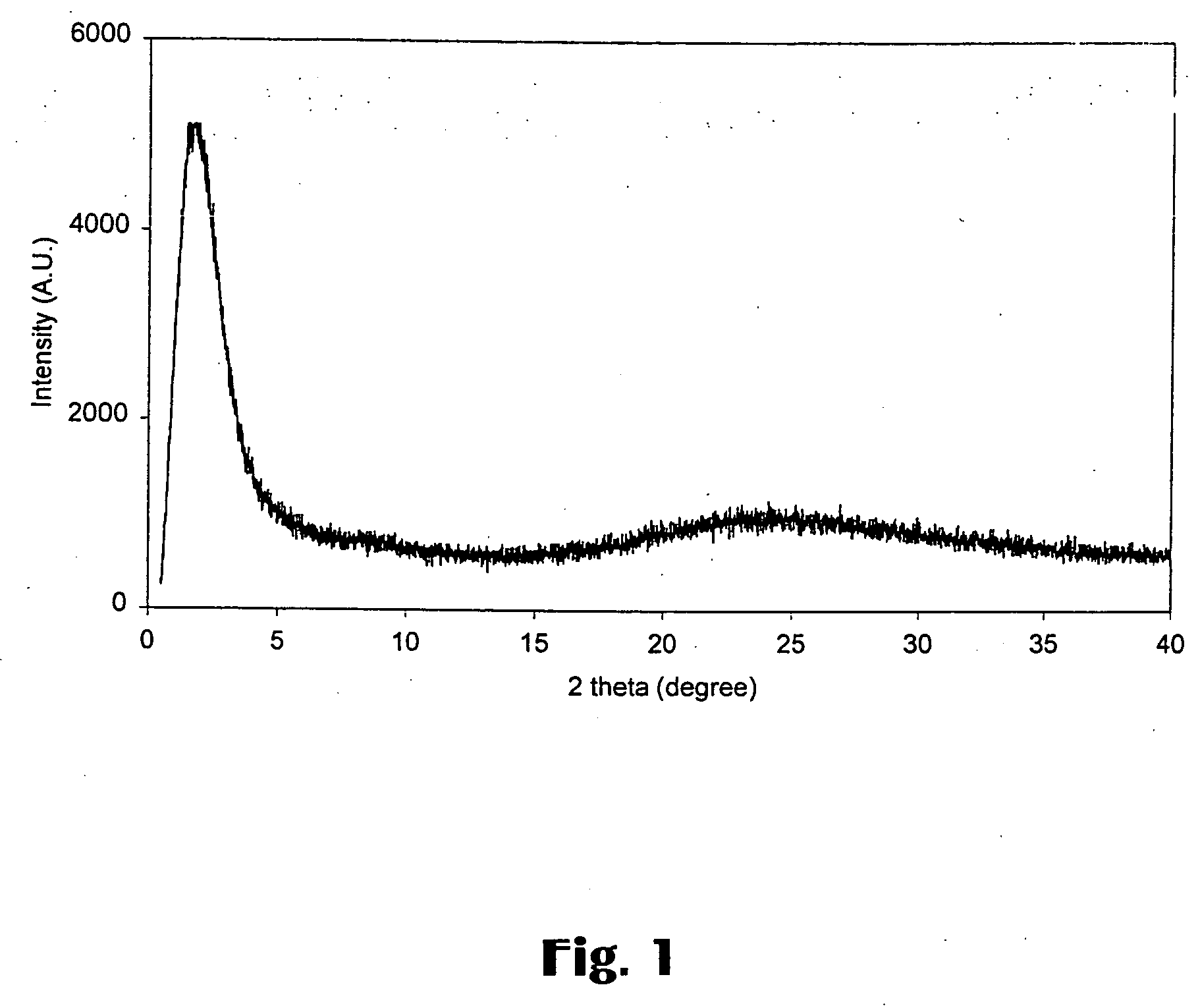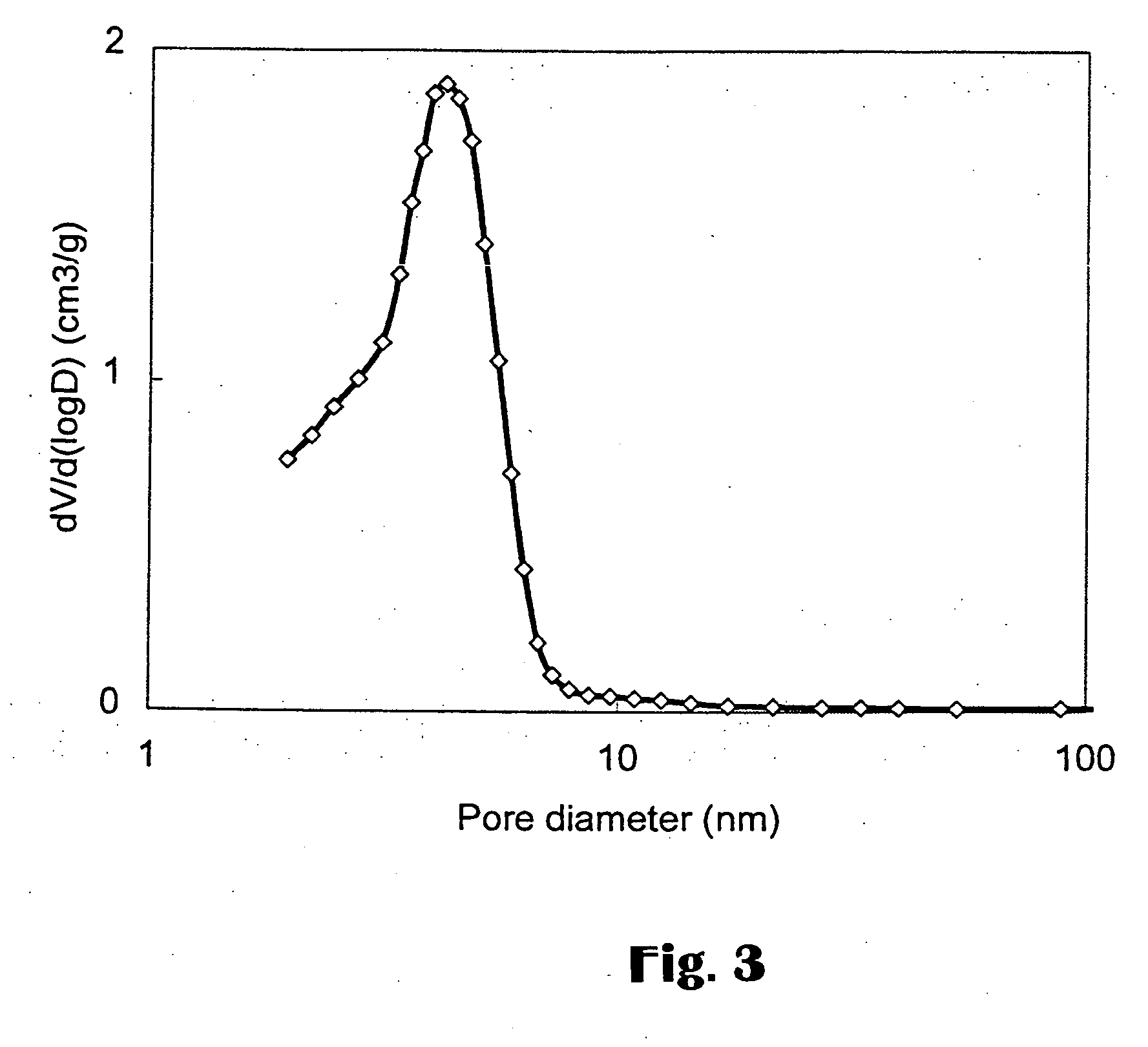Mesoporous material with active metals
a technology of mesoporous materials and active metals, applied in the field of catalytic materials, can solve the problems of metals, sulfur, nitrogen, ccr content of residual fractions, limiting their effective use, and premature aging of catalysts and/or unwanted side reactions, and substantial sox emissions
- Summary
- Abstract
- Description
- Claims
- Application Information
AI Technical Summary
Benefits of technology
Problems solved by technology
Method used
Image
Examples
example 1
[0067] This example shows how to incorporate aluminum into silica without heating in an autoclave before calcination.
[0068] First, 1 part aluminum isopropoxide (Al(iso-OC3H6)3) was added into 26 parts of an aqueous solution of tetraethylammonium hydroxide (TEAOH, 35%) while stirring. After dissolution, 38 parts of triethanolamine (TEA) together with 8 parts of water were added into the above solution under stirring. Then, 26 parts of tetraethyl orthosilicate (TEOS) were added under vigorous stirring. A clear solution was obtained. The stirring was continued for 1 hour, and then the synthesis mixture was aged at room temperature overnight and dried at 98° C. in air for 24 hours. Finally, the synthesis mixture was calcined at 570° C. for 10 hours in air with a ramp rate of 1° C. / min.
[0069]FIG. 1 shows its XRD pattern with an intensive reflection at about 1.1° in 2 θ, indicating the characteristic of a mesoporous material. In addition, the absence of resolved peaks for alumina implie...
example 2
[0070] This example demonstrates the incorporation of heteroatoms with heating in an autoclave before calcination. 3.3 Parts of aluminum isopropoxide were added into a bottle with 42 parts of TEOS and stirred for an hour. A mixture of 7.6 parts of TEA and 25.8 parts of water were added into the mixture of TEOS and Al(iso-OC3H6)3 under stirring. After 2 hours stirring, 21 parts of TEAOH were drop-wise added into the above mixture and a thick gel formed. The gel was dried in an oven at 98° C. for 22 hours and then transferred into an autoclave at 190° C. for 16 hours. Finally the gel was calcined at 600° C. for 10 hours in air.
[0071]FIG. 4 shows its XRD pattern with an intensive reflection at a low angle in 2 θ, indicating the characteristic of mesoporous material. Elemental analysis showed its Si / Al ratio of about 24.5, consistent with the ratio of initial synthesis mixture was 25. Nitrogen adsorption revealed a surface area of 799 m2 / g, a total pore volume of 1.24 cm3 / g and a narro...
example 3a
[0072] This demonstrates the incorporation of aluminum and its stability of the composition. 3 Parts of aluminum isopropoxide were added into a bottle with 38.8 parts of TEOS and stirred for 1.5 hours. A mixture of 23 parts of TEA and 21 parts of water was added into the above mixture under stirring. After 2 hours stirring, 23 parts of TEAOH were drop-wise added into the above mixture and after 0.5 hours stirring it turned into a clear solution. The solution was dried in an oven at 100° C. for 4 days and then transferred into an autoclave at 190° C. for 7.5 days. Finally it was calcined at 600° C. for 10 hours with a ramp rate of 1° C. / min in air.
[0073] Elemental analysis showed the Si / Al ratio to be 99.2. FIG. 5 shows its XRD pattern with an intensive peak. Nitrogen adsorption shows a narrow pore size distribution centered at 17 nm, as presented in FIG. 6, which exhibited a surface area of about 385 m2 / g, and a pore volume of about 1.32 cm3 / g.
PUM
| Property | Measurement | Unit |
|---|---|---|
| diameter | aaaaa | aaaaa |
| diameter | aaaaa | aaaaa |
| 2θ | aaaaa | aaaaa |
Abstract
Description
Claims
Application Information
 Login to View More
Login to View More - R&D
- Intellectual Property
- Life Sciences
- Materials
- Tech Scout
- Unparalleled Data Quality
- Higher Quality Content
- 60% Fewer Hallucinations
Browse by: Latest US Patents, China's latest patents, Technical Efficacy Thesaurus, Application Domain, Technology Topic, Popular Technical Reports.
© 2025 PatSnap. All rights reserved.Legal|Privacy policy|Modern Slavery Act Transparency Statement|Sitemap|About US| Contact US: help@patsnap.com



